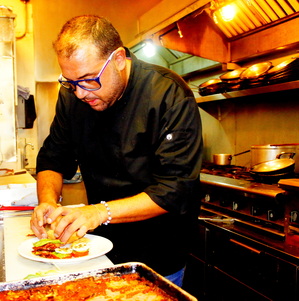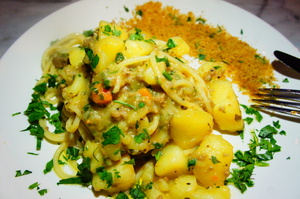What do we have now, a dozen pizzerias on Capitol Hill? At least, if you count every oven from Jackson and the Ship Canal. But Seattle does not live by pies alone. If you're the owner of a pizza parlor, you've got to do something else to bring in the hungry wanderers.
At Dino's on E.Olive, owner and pizzaiolo Brandon "Dino" Pettit has a very precise, even doctrinaire, approach to pizza. Round, crusty, what some call "overbaked." But never forgotten. Watch him attend to every pie in the deck, turning, lifting the edges, turning again, until the bottom is (to his eyes, at any rate) perfect. Only then does it come out and make its way to the counter. You want pesto? $22, and round only. You want a Sicilian, with hot salami? $25. The difference? Sicilians are baked in square sheet pans. The crust is much thicker (more like bread), and it appears there's less goopy sauce. And you can buy it by the slice after 10 p.m.
 Across from the QFC is Pizzeria Ottantotto, at 416 Broadway E. The name is Italian for the number 88. The backstory: Ottantotto was the name of a pub that Enza Sorrentino used to run in Palermo. Enza lives in Seattle now and runs the kitchen at Mondello Ristorante in Magnolia; Ottantotto is the latest Seattle restaurant venture from her son, Corino. (It's a sweet tribute to his Mamma.) Anyway, Corino and a couple of helpers take care of the thin-crust pies, baked in a combination gas-and-wood oven. But as we said, Broadway's storefronts need to offer more than pizza to draw customers.
Across from the QFC is Pizzeria Ottantotto, at 416 Broadway E. The name is Italian for the number 88. The backstory: Ottantotto was the name of a pub that Enza Sorrentino used to run in Palermo. Enza lives in Seattle now and runs the kitchen at Mondello Ristorante in Magnolia; Ottantotto is the latest Seattle restaurant venture from her son, Corino. (It's a sweet tribute to his Mamma.) Anyway, Corino and a couple of helpers take care of the thin-crust pies, baked in a combination gas-and-wood oven. But as we said, Broadway's storefronts need to offer more than pizza to draw customers.
So Ottantotto has added a genuine Sicilian chef, the stouthearted, earnest, talented Vincenzo "Vik" Tarantino, recently arrived from Palermo and enthusiastically executing a genuine Sicilian menu.
 One of the first things you learn about Italian food is that no two Italians agree on how to make something, let alone whose mamma makes it best. There are geographical fault lines as well. We argue here in North America over the merits of Kansas City barbecue, Texas barbecue (West Texas? East Texas? Cowboy style?), Memphis-style, mustardy South Carolina, whole-hog North Carolina, and so on. Well, that's a whole continent, shaped by different clusters of immigrant butchers, which resulted in different cuts (back ribs, butt, shoulder, etc.) let alone evolving traditions of local spices or local wood. Now, pile all that regional pride, centuries of tradition and overlays of Spanish, French, Greek, African and Arab culinary culture into a single Mediterranean island the size of Vermont, and you get the splendid tapestry that is Sicily. It's only a two-hour drive across the island, but the food is dramatically different.
One of the first things you learn about Italian food is that no two Italians agree on how to make something, let alone whose mamma makes it best. There are geographical fault lines as well. We argue here in North America over the merits of Kansas City barbecue, Texas barbecue (West Texas? East Texas? Cowboy style?), Memphis-style, mustardy South Carolina, whole-hog North Carolina, and so on. Well, that's a whole continent, shaped by different clusters of immigrant butchers, which resulted in different cuts (back ribs, butt, shoulder, etc.) let alone evolving traditions of local spices or local wood. Now, pile all that regional pride, centuries of tradition and overlays of Spanish, French, Greek, African and Arab culinary culture into a single Mediterranean island the size of Vermont, and you get the splendid tapestry that is Sicily. It's only a two-hour drive across the island, but the food is dramatically different.
I've been a regular diner at Mamma Enza's kitchens (in Belltown, Queen Anne and Magnolia) for a decade, so when I order her eggplant appetizer called caponata I know what to expect: a sweet-sour blend of eggplant, onions, celery, olives, capers, vinegar, and puréed tomatoes. Imagine my surprise, then, when Vik served me his version of caponata: plenty of eggplant, plenty of tomato, but only a few capers. Very tasty, very different. "Palermo-style," he said. "Mamma's is from Catania." Well, yes, Enza had worked in Catania (Sicily's second-largest city) for several years.
Vik is justly proud of his spaghetti "glassa," which is a braised beef-and-potato sauce. He serves it topped not with cheese but with a generous dollop of breadcrumbs at the edge of the plate. Cheese, until after World War II, was a luxury reserved for the wealthy; working-class diners made do with bread. Tarantino's Insalata Vastasa is a standout: like a French salade niçoise with anchovies substituting for tuna. His meaty ragù is another Palermo-style recipe, with capers alongside the ground beef.
Let's get back for a moment to the pizza. The inside of the domed oven gets so hot that it literally bakes a pizza in just over a minute. My favorite is the Napolitano, which covers the pie with anchovies and capers. Salty? Fishy? Sure, but no more so than a tuna sandwich. Intensely tasty.
See more here.
Leave a comment